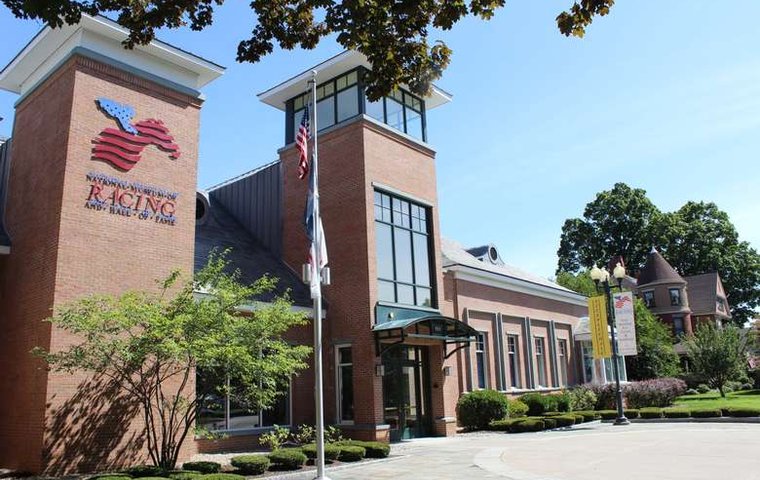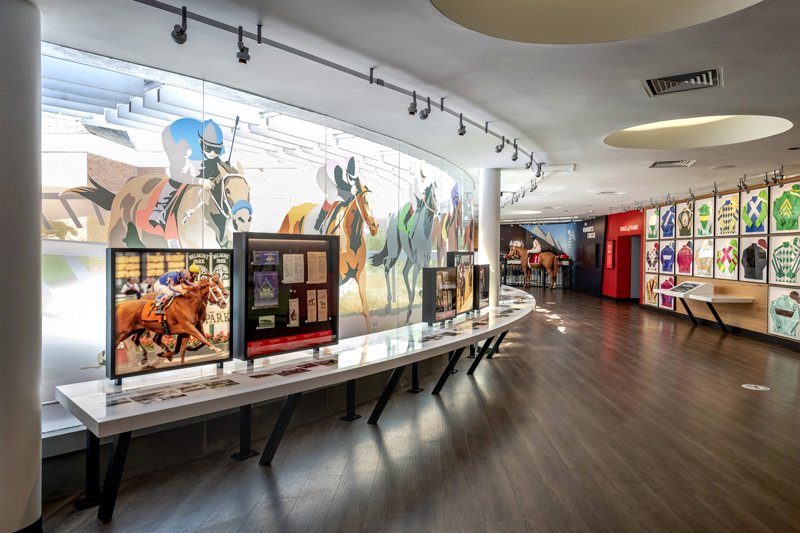
My first memories of the National Museum of Racing and Hall of Fame in Saratoga Springs are tinged with gold. I was a teenager, maybe a little younger, the first time I was there, and in my memory it was all marble, laced with gold, studded with gleaming trophies. It felt like a holy place, a place in which to speak in hushed tones and observe reverently.
As the idea of what a museum should be evolved, as directors of museums realized that visitors could, and wanted to, be more than respectful observers, the Racing Museum undertook a massive renovation project in the late 1980s.
In that iteration, the exhibits were interactive. Visitors could walk through a starting gate. They could ride a mechanical horse in a simulated race. The gold and the gleam were still there, but the atmosphere was lighter and more inviting, more democratic, even, and less the realm of the gatekeepers of the sport.
The Hall of Fame always inspired awe: No matter how many times I visited, I’d gaze at the silks rimming the room, testing myself on how many I could correctly match with their owners. No matter how much time I had, it was never enough to circle the exhibits and read all the plaques, to absorb the accomplishments of the trainers, owners, and jockeys; each visit was a history lesson that invited me to go home and research on my own, to learn more about the people and animals memorialized therein.
It’s hard to believe that that was 30 years ago, that the “new Museum” had long since reached full adulthood and in museum years was in fact itself something of an artifact.
The Museum that re-opened a year ago - following a Covid closure that coincided closely with its most recent renovation - bears about as much resemblance to its 1980s self as a Tesla does to a Packard: The same basic machine, but while those old models were enviable and state-of-the-art at the time, these newfangled contraptions get the job done much, much better.
As I paid my admission on a recent visit, a basket of mini-keychain/stylus combinations sat on the counter; visitors were exhorted to use them on the ubiquitous touchscreens instead of using their fingers, a reminder of the risks of coronavirus infection. Virtually every exhibit had an interactive element, offering visitors the ability to customize their experience.
The gallery devoted to Triple Crown winners includes an audio-video portal that includes not only the Kentucky Derby, the Preakness, and the Belmont, but also other notable races won by the 13 horses to have won the Triple Crown.
Videos tell the stories of those horses, putting their accomplishments in contemporary context though race replays, photographs, and voiceover narrative. The obvious downside to the exhibit is the poor person who gets stuck behind history geeks like me who will perhaps need to be rather strongly urged to move along and give others a chance.

I stood rapt before a video on equine anatomy; if you’ve ever wondered what people are talking about when they mention pasterns or colic or hoof dynamics, you’ll walk away knowing more than you ever thought you would about how horses are put together.
Consecutive galleries detail the history of Thoroughbred racing in the United States, with rooms devoted to the pre-Civil War era, post-Civil War, and 20th century. For the first time, I noticed that some of the display mannequins were not white, a step towards acknowledging the primacy of Black horsemen in the 19th and early 20th centuries.
The immersive 16-minute film that is shown at regular intervals in the Hall of Fame is subtitled, as are many — though not all — of the video displays, making them accessible to non-hearing visitors. Featuring the voices of jockeys, trainers, owners, breeders, and racing luminaries, it plays first along the walls, rather where those owners’ silks used to be, and then on screens that drop down from the ceiling in the center of the room.
Viewers are treated to images of horses of all ages, from foals to breeding stock, to pastoral vistas of farms, to races at some of the country’s most beautiful tracks.
Gone from the room are the umber plaques, replaced with video display panels on which users can select virtual galleries of the horses, trainers, and jockeys that have been inducted into the Hall of Fame. Select Bill Mott’s name, for instance, and you get a summary of his career accomplishments along with options to watch race videos of horses like Cigar and Royal Delta.
According to museum director Cate Masterson, there is no limit to the information that each virtual display can contain. The late Allen Jerkens used to say wistfully, “It looks like I didn’t do any good after 1975,” the year that he was inducted and when his plaque was created. Now, Jerkens’ biography can include some of his nearly 200 Graded stakes wins after his induction.
“Generally, when there’s a major milestone or change, the information is updated within 24 hours,” said Masterson.
As with all technology, one must expect glitches, the occasional missing video or typo, and Masterson encourages visitors to let staff know if they encounter a problem, which can usually be remedied quickly.
The plaques removed from the Hall are on temporary loan to Belmont Park, where they will be displayed on the second floor. The Museum is considering options for them to become something of a traveling exhibit at other racetracks.
The Women in Racing exhibit that opened in 2019 is still open, and women’s voices are featured prominently in the new movie. The Museum has in recent years focused on making sure that the accomplishments of women, of Black people, and of people of Latin-American descent are included in the stories it tells about Thoroughbred racing.
As with so many North American institutions, it still has work to do: The story of the sport cannot be truly and fully told without a comprehensive history of Black jockeys and trainers, and I hope that the Museum’s recent efforts to honor that history will continue.
I admit that I do sort of miss the old Hall of Fame; I miss the beauty and color of the owners’ silks, and I miss the easy visuals of those old bronze plaques. The new one feels stark, even cold, to me, at least until the screens spring to life, bringing images and voices of the past and the present into the space, positioning the Museum itself formidably for the future.
Disclosures: The author is a member of the Hall of Fame nominating committee, and her mother was employed by the Museum during the 1980s, serving briefly as its director.


